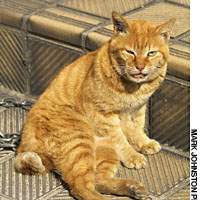Dear Alice,
I'm crazy about cats but my landlady won't allow pets. I've tried to make nice with the neighborhood nora-neko (alley cats) but, to be honest, their stumpy twisted tails gross me out. What the heck is that, anyway? Some kind of infection? My landlady claims Japanese people don't like tails on cats so they tie strings around kittens' tails to make 'em fall off. Tell me it ain't so!
Ingrid S., Saitama
It's not true, Ingrid. Although many cats in Japan do indeed have abbreviated tails, it's not caused by disease or mutilation. The short tail is a genetic trait common in many parts of Asia, including coastal China.
Cats first came to Japan more than a thousand years ago, probably as mousers on Chinese ships. They had no trouble finding work on Japanese farms, where they were used to protect rice and silkworms from vermin. Others took jobs in Buddhist temples, persuading mice not to eat the religious scrolls.
To answer your question, I tracked down Kyoto University professor emeritus Ken Nozawa, who spent several decades studying the genetic makeup of feral cat groups. He estimates that 30 to 40 percent of Japanese street cats have short tails, with significant geographical variation. Shiga Prefecture, for example, has relatively few short-tailed cats, while Nagasaki, where much of the early trade with China took place, has a lot.
Nozawa-sensei and I were having a great interview until I asked if the gene for short tails is yusei (dominant) or ressei (recessive), a misstep because my Japanese is not up to scientific discussions. He lost me, and fast.
So I called my friend Abby, who by happy coincidence has both a PhD in genetics and a thing for cats with short tails. She listened to what little I had understood, and explained that Prof. Nozawa had said that tail length in Japanese feral cats is under the control of many genes, each having such a small effect that a cat with a mutation in just one (or even several) of the genes would have a normal long tail. It's only when a cat has the mutation in all the genes that you get the fully stunted tail. So it would seem, Ingrid, that your neighborhood has some seriously mutated meow-meows.
While I tend to agree that a cat doesn't seem fully feline unless it has a long swisher, some folks value those stubby tails. In 1968, an American cat breeder named Elizabeth Freret got her hands on three short-tailed kittens from Japan and started an effort to get them recognized as a new breed.
Her work paid off -- since 1976, the Cat Fanciers' Association has recognized descendents of these and subsequent imports as a championship breed called the Japanese Bobtail. Show cats' tails must fit categories with names like "shaving brush" and "clown's pompom." Pretty la-di-da for the offspring of mixed-breed farm cats.
To round off my research, I consulted my 10-year-old's encyclopedia of kotowaza (proverbs). The Japanese language is rich in expressions thatinvolve cats, my favorite being "neko o kaburu" (put a cat on one's head), which means to feign innocence. I figured there was a good chance we'd find some proverb about cats' tails, and sure enough, we did. It's "attemo nakutemo neko no shippo" (have or have not, a cat's tail) and is used to describe something so unimportant it doesn't matter whether you have it or not.
So there you have it, Ingrid. Or not.


















With your current subscription plan you can comment on stories. However, before writing your first comment, please create a display name in the Profile section of your subscriber account page.